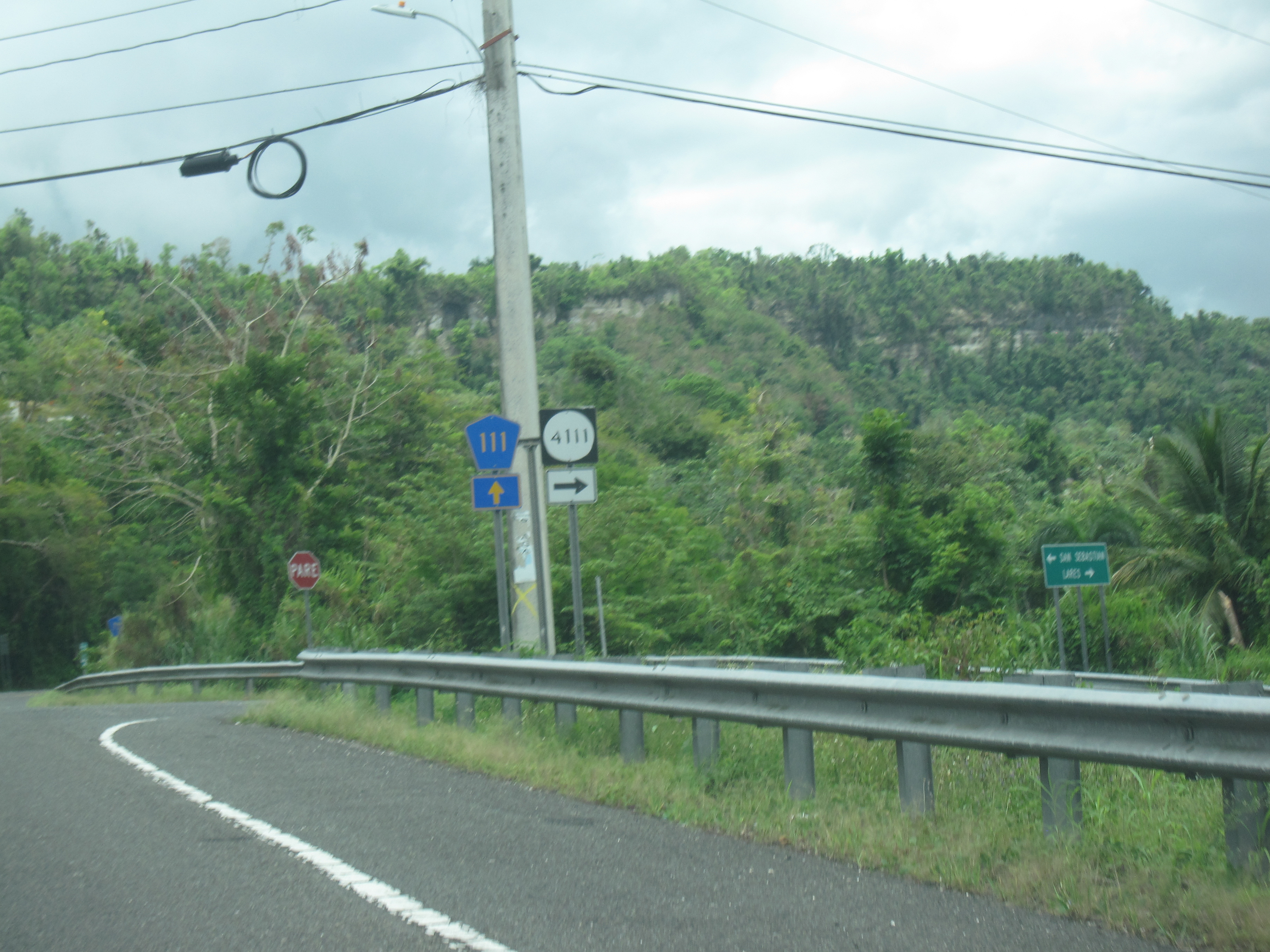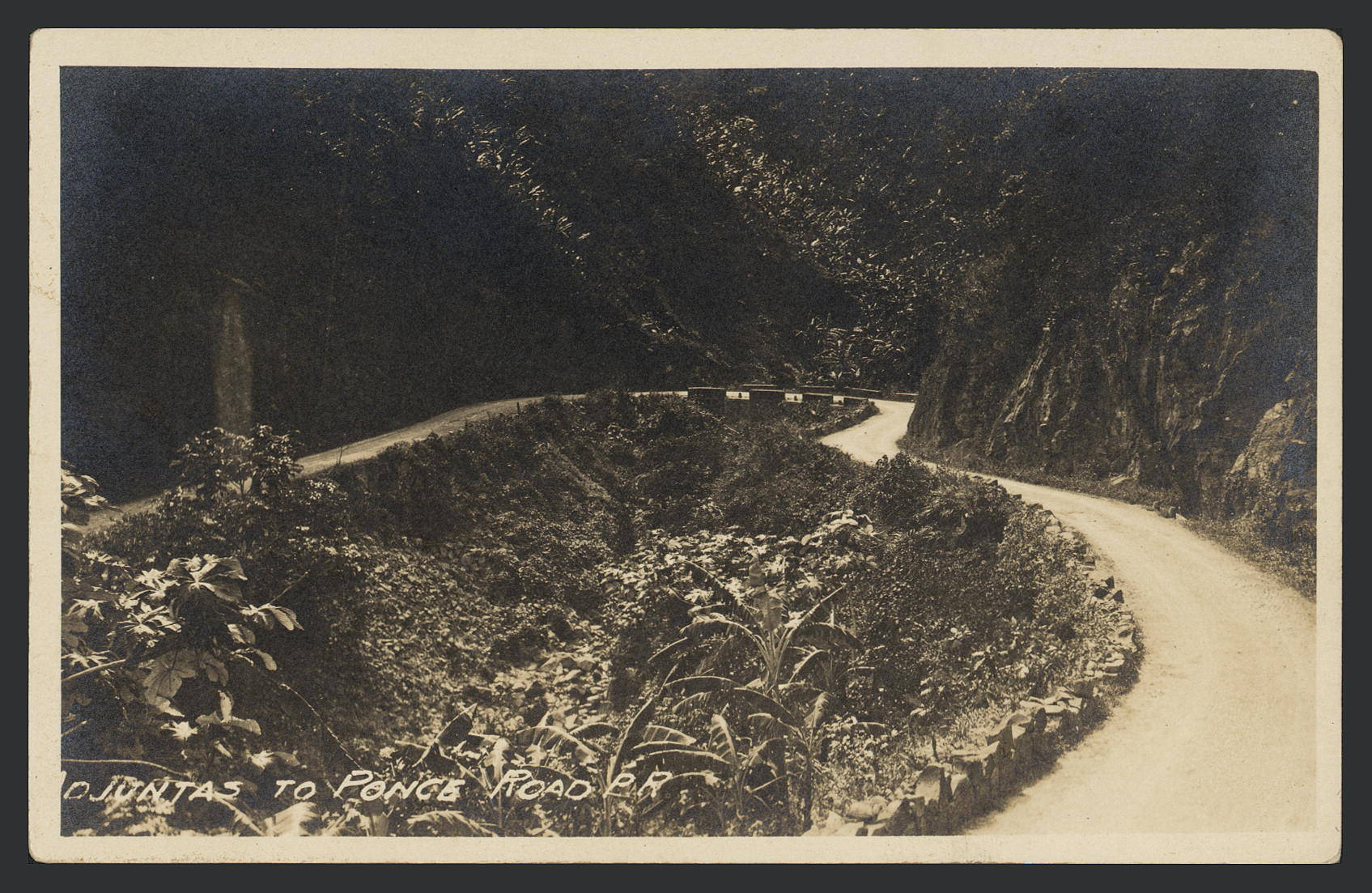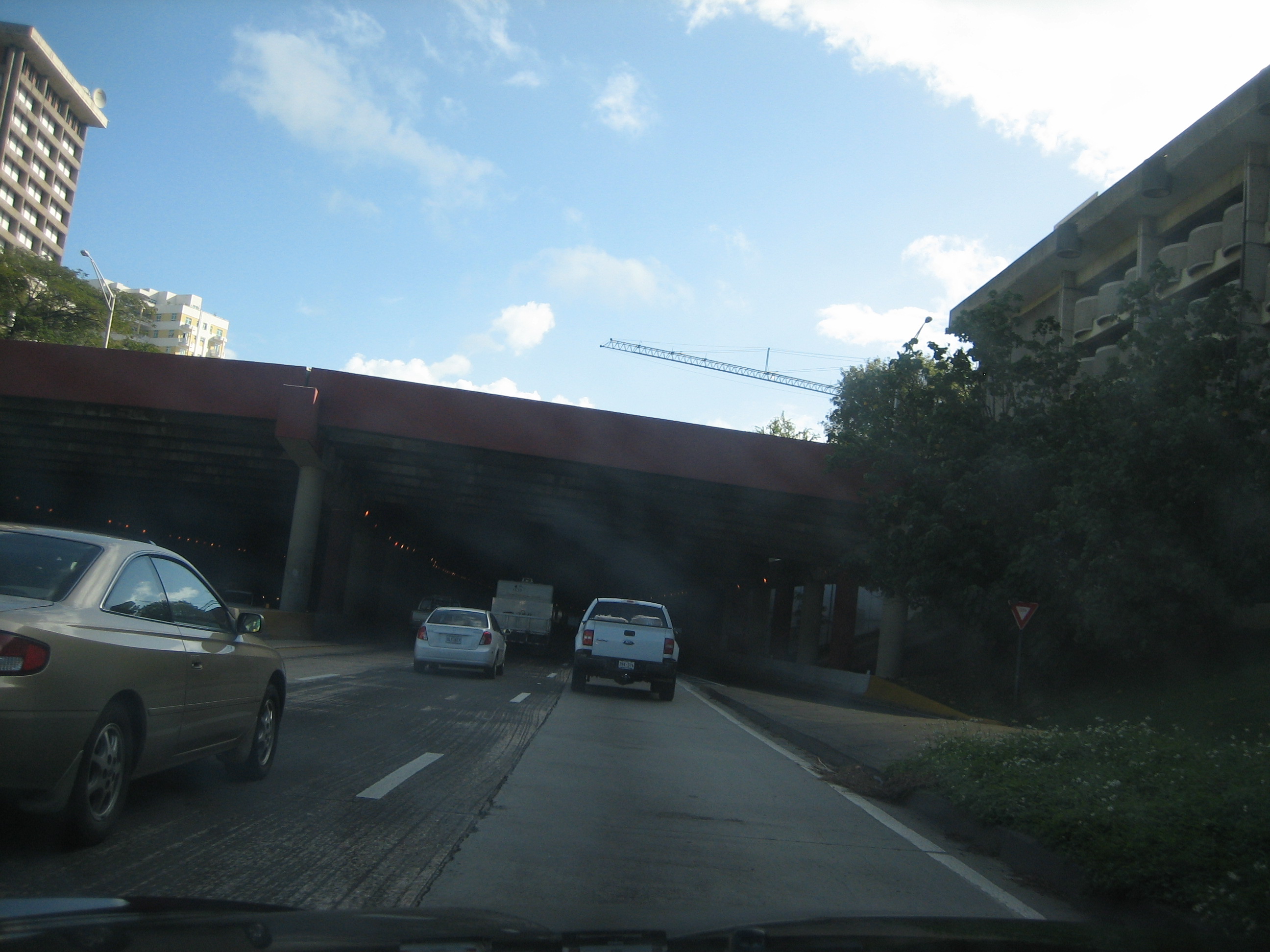|
PR-111
Puerto Rico Highway 111 (PR-111) is a highway connecting Aguadilla, Puerto Rico at Puerto Rico Highway 2 and Puerto Rico Highway 115 to Utuado, Puerto Rico at Puerto Rico Highway 140. Route description It is the main highway to Moca and San Sebastián, being a two-lane highway before turning rural on its way to Lares, where it meets PR-129, which taking north goes to Arecibo and meets PR-2 and PR-22. In Lares, it becomes a divided avenue, replacing an old, narrow segment, but then becomes rural again. It continues to Utuado, crossing PR-10, and merging shortly with PR-123. It ends at PR-140 east of Utuado, near Jayuya. It is one of two long highways going west–east through the center of Puerto Rico (the other being PR-156). It is named the ''Carretera Enrique Laguerre'' through all its length. Aguadilla Pueblo.jpg, PR-111 on the Aguadilla pueblo coast Planta electrica en PR-111, Bahomamey, San Sebastián, Puerto Rico.jpg, Electric plant on PR-111 in Bahomamey Parque de P ... [...More Info...] [...Related Items...] OR: [Wikipedia] [Google] [Baidu] |
Puerto Rico Highway 129
PR-129 is a north–south (actually diagonal) highway in North-Central Puerto Rico, connecting the town of Lares with Arecibo. It crosses the northern karst country of the island. When traveling from the northern coast of Puerto Rico, PR-129 can be used to reach the Arecibo Observatory and the Camuy River Caverns Park. Route description PR-129.jpg, PR-129 near the interchange with PR-22 in Arecibo PR Highway 134 junction sign from 129.jpg, PR-134 junction sign in Bayaney barrio, Hatillo Sign for Arecibo Observatory from PR Hwy 129 North.jpg, Sign for Arecibo Observatory from PR-129 (northbound) It is a four-lane, divided highway in Arecibo, and a super two highway in Hatillo, Camuy Camuy () is a town and municipality of Puerto Rico, bordering the Atlantic Ocean, north of Lares and San Sebastián; east of Quebradillas; and west of Hatillo. Camuy is spread over 12 barrios and Camuy Pueblo (the downtown area and the admini ... and Lares. It then merges with PR-111, ... [...More Info...] [...Related Items...] OR: [Wikipedia] [Google] [Baidu] |
Puerto Rico Highway 123
Puerto Rico Highway 123 (PR-123) is a secondary highway that connects the city Arecibo to the city of Ponce, Puerto Rico, Ponce. It runs through the towns of Utuado and Adjuntas, before reaching Ponce. A parallel road is being built, PR-10, that is expected to take on most of the traffic currently using PR-123. History The road dates from the late 19th century and it started as a road to link the coffee-farming mountain town of Adjuntas to the southern port city of Ponce for the export of coffee. (Eventually the road was completed to the smaller northern port city of Arecibo as well, connecting the mountain town of Utuado in its way.) PR-123 was built under the colonial government of Spain in Puerto Rico to connect the coffee-growing town of Adjuntas, Puerto Rico, Adjuntas to the port city of Ponce as a farm-to-market road. [...More Info...] [...Related Items...] OR: [Wikipedia] [Google] [Baidu] |
Bahomamey
Bahomamey is a barrio in the municipality of San Sebastián, Puerto Rico. Its population in 2010 was 2,218. History Puerto Rico was ceded by Spain in the aftermath of the Spanish–American War under the terms of the Treaty of Paris of 1898 and became an unincorporated territory of the United States. In 1899, the United States Department of War conducted a census of Puerto Rico finding that the combined population of Bahomamey barrio and Guatemala barrio was 1,126. Sectors Barrios (which are roughly comparable to minor civil divisions) in turn are further subdivided into smaller local populated place areas/units called sectores (''sectors'' in English). The types of ''sectores'' may vary, from normally ''sector'' to ''urbanización'' to ''reparto'' to ''barriada'' to ''residencial'', among others. The following sectors are in Bahomamey barrio: , and . Gallery Carretera 111 en Bahomamey, San Sebastián, Puerto Rico.jpg, PR-111R in Bahomamey Planta electrica en PR-111, Bahomam ... [...More Info...] [...Related Items...] OR: [Wikipedia] [Google] [Baidu] |
Puerto Rico Highway 2
Puerto Rico Highway 2 (PR-2) is a road in Puerto Rico that connects the cities of San Juan and Ponce. At 156 miles (230 km) long, it is Puerto Rico's longest singled-signed highway. The road runs counter-clockwise from San Juan to Ponce. PR-2 runs parallel to the northern coast of Puerto Rico (west of San Juan), then parallel to the west coast from near Aguadilla running south through Mayagüez. Shortly after Mayagüez, the road runs somewhat inland (through Hormigueros, San Germán and Sabana Grande) until it reaches the southern coast of Puerto Rico at Yauco, and continues to run parallel the southern shore as it approaches Ponce from the west. In addition to Arecibo, Aguadilla, and Mayagüez, the road runs through various other cities including Guaynabo, Bayamón, San Germán and Yauco. In some sections the road is a four-lane highway while in other sections the road is either a six-lane or eight-lane highway. The section of PR-2 from Ponce to the PR-22 interchange ... [...More Info...] [...Related Items...] OR: [Wikipedia] [Google] [Baidu] |
Hato Arriba, San Sebastián, Puerto Rico
Hato Arriba is a barrio in the municipality of San Sebastián, Puerto Rico. Its population in 2010 was 1,980. History Puerto Rico was ceded by Spain in the aftermath of the Spanish–American War under the terms of the Treaty of Paris of 1898 and became an unincorporated territory of the United States. In 1899, the United States Department of War conducted a census of Puerto Rico finding that the population of Hato Arriba barrio was 663. PR-111 and PR-119 On September 20, 2017, a section of PR-111 in Hato Arriba "almost disappeared completed" according to witnesses of the effects of Hurricane Maria. In late May 2019, a lane of PR-119, a principal road in Hato Arriba, collapsed due to heavy rain. This highway had experienced a visible depression with Hurricane Maria in 2017 and was on a project waiting list when it collapsed further. Sectors Barrios (which are roughly comparable to minor civil divisions) in turn are further subdivided into smaller local populated place areas/uni ... [...More Info...] [...Related Items...] OR: [Wikipedia] [Google] [Baidu] |
Lares, Lares, Puerto Rico
Lares is a barrio in the municipality of Lares, Puerto Rico. Its population in 2010 was 3,405. History Puerto Rico was ceded by Spain in the aftermath of the Spanish–American War under the terms of the Treaty of Paris of 1898 and became an unincorporated territory of the United States. In 1899, the United States Department of War conducted a census of Puerto Rico finding that the population of Lares barrio was 1,954. Sectors Barrios (which are roughly comparable to minor civil divisions A minor civil division (MCD) is a term used by the United States Census Bureau for primary governmental and/or administrative divisions of a county or county-equivalent, typically a municipal government such as a city, town, or civil township. MCD ...) and subbarrios, in turn, are further subdivided into smaller local populated place areas/units called sectores (''sectors'' in English). The types of ''sectores'' may vary, from normally ''sector'' to ''urbanización'' to ''reparto'' to ''barr ... [...More Info...] [...Related Items...] OR: [Wikipedia] [Google] [Baidu] |
Puerto Rico Highway 10
Puerto Rico Highway 10 (PR-10) is a major highway in Puerto Rico. The primary state road connects the city of Ponce in the south coast to Arecibo in the north; it is also the shortest route between the two cities. Construction on the modern PR-10, a new highway, began in 1974. The highway is being built parallel to the old PR-10; that road is now signed PR-123. Most of the new PR-10 is now complete, with an approximately stretch still remaining to be finished. In its current state it is a freeway only in the completed portions, which consists of over three-fourths of the highway. In May 2010, Autoridad de Carreteras estimated the road would be completed in 2015, at a cost of $500 million. Upon completion, the highway is expected to become one of the two major roads on the island that cross the Cordillera Central mountain range. The first section of the road was inaugurated in the year 2000. After "more than 40 years" since the project was initiated, as of 22 January 2017, ... [...More Info...] [...Related Items...] OR: [Wikipedia] [Google] [Baidu] |
Aguadilla, Puerto Rico
Aguadilla (, ), founded in 1775 by Luis de Córdova, is a city and municipality located in the northwestern tip of Puerto Rico, bordered by the Atlantic Ocean to the north and west, north of Aguada, and Moca and west of Isabela. Aguadilla is spread over 15 ''barrios'' and Aguadilla Pueblo (the downtown area and the administrative center of the city). It is a principal city and core of the Aguadilla-Isabela-San Sebastián Metropolitan Statistical Area. Etymology and nicknames Aguadilla is a shortening of the town's original name ''San Carlos de La Aguadilla''. The name ''Aguadilla'' is a diminutive of '' Aguada'', which is the name of the town and municipality located to the south. Some of the municipality's nicknames are: ''Jardín del Atlántico'' ("Garden of the Atlantic"), ''Pueblo de los Tiburones'' ("Shark Town") and ''La Villa del Ojo de Agua'' ("Villa of the Water Spring") after the natural water spring that was used by early settlers and Spanish soldiers as a wate ... [...More Info...] [...Related Items...] OR: [Wikipedia] [Google] [Baidu] |
Puerto Rico Highway 140
{{PuertoRico-road-stub ...
Puerto Rico Highway 140 (PR-140) is a road that travels from Jayuya, Puerto Rico to Barceloneta, passing through Utuado, Ciales and Florida. This highway begins at PR-143 in Pica barrio and ends at PR-2 in Florida Afuera barrio. Major intersections Signs for PR-140 and PR-684 in Barceloneta, Puerto Rico.jpg, Signs for PR-140 in Barceloneta PR-140, Florida Farmacéuticas, Salida 57 sign on PR-22.jpg, Sign for PR-140, and Florida pharmaceuticals, Exit 57 from PR-22 Carretera PR-140, Ciales, Puerto Rico.jpg, Puerto Rico Highway 140 in Ciales See also *List of highways numbered 140 References External links * 140 140 may refer to: * 140 (number), an integer * AD 140, a year of the Julian calendar * 140 BC, a year of the pre-Julian Roman calendar * ''140'' (video game), a 2013 platform game * Tin King stop Tin King () is an at-grade MTR Light Rail stop ... [...More Info...] [...Related Items...] OR: [Wikipedia] [Google] [Baidu] |
Arecibo, Puerto Rico
Arecibo (; ) is a city and municipality on the northern coast of Puerto Rico, on the shores of the Atlantic Ocean, located north of Utuado and Ciales; east of Hatillo; and west of Barceloneta and Florida. It is about west of San Juan, the capital city. Arecibo is the largest municipality in Puerto Rico by area, and it is the core city of the Arecibo Metropolitan Statistical Area and part of the greater San Juan Combined Statistical Area. It is spread over 18 ''barrios'' and Arecibo Pueblo (the downtown area and the administrative center of the city). Its population in 2020 was 87,754. The Arecibo Observatory, which housed the Arecibo telescope, the world's largest radio telescope until July 2016, is located in the municipality. The Arecibo telescope collapsed on December 1, 2020. Arecibo is the seat of the Roman Catholic Diocese of Arecibo. Etymology and nicknames The name ''Arecibo'' comes from the Taíno chief Xamaica Arasibo, cacique of the ''yucayeque'' (Taíno ... [...More Info...] [...Related Items...] OR: [Wikipedia] [Google] [Baidu] |
Puerto Rico Highway 22
PR-22 (also part of unsigned Interstate PR2) is an long toll road in the north coast of Puerto Rico that connects the cities of San Juan and Hatillo. The road is also known as the ''José de Diego Expressway'' (Spanish: ''Expreso José de Diego''), and is part of unsigned Interstate PR-2. It is a 4-lane road for much of its length, but expands to up to 12 lanes in the San Juan metro area. The road is frequently congested, in particular during rush hour due to heavy commuter traffic. Route description PR-22 is Puerto Rico's most traveled highway. PR-22 runs parallel to PR-2 and is concurrent with unsigned Interstate Highway PRI-2. Unlike PR-22, PR-2 is not a controlled-access road, and has numerous traffic signals throughout the full run of its course. The construction of highway PR-22 reduced congestion on PR-2. The eastern terminus is at PR-26 (a non-tolled freeway) in Santurce, and passes through the Minillas Tunnel before its terminus at PR-26. The freeway bypasses al ... [...More Info...] [...Related Items...] OR: [Wikipedia] [Google] [Baidu] |
Puerto Rico Planning Board
The Puerto Rico Planning Board ( es, Junta de Planificación) created in the May 12, 1942 during Rexford G. Tugwell's governorship as the Puerto Rico Planning, Urbanization, and Zoning Board, is the only government agency in charge of centralized planning under the American flag. Its creation was in keeping with Tugwell's New Deal philosophy that Puerto Rico should operate under a highly centralized, all-encompassing territorial government. For decades, the Planning Board was in charge of all economic planning, land use zoning and case-by-case permitting in Puerto Rico. In the 1970s the permitting process was delegated to another government agency, the Rules and Permits Administration (ARPE) and since the late 1990s, major cities have been taking over that role in their own jurisdictions. Organization The Planning Board currently has a Chair and four Associate Members, all appointed by the Governor and requiring the consent of the Puerto Rico Senate. Presidents The following ... [...More Info...] [...Related Items...] OR: [Wikipedia] [Google] [Baidu] |


